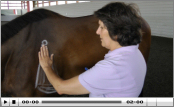|
Gait Analysis at the Walk: How to
Evaluate Restrictions in Motion Caused by Simple Muscle Tightness.
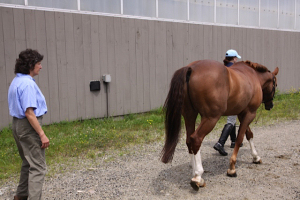 I
get the best view of muscle function at the walk. The slower one
moves, the more muscle one uses. Before I work on a horse, I often
ask to see the horse walk in a straight line away from me and then
back toward me. I can see fairly well any restriction that may be
caused by simple muscle tightness. I can relate what I see to the
way a horse performs. For instance, if a horse is delayed in
bringing his right shoulder forward, then he may be harder in
extending the shoulder in such moves as picking up the right lead
canter, or in lengthening’s. I was recently called to a barn to use
sportsmassage on a show jumper competition horse. I
get the best view of muscle function at the walk. The slower one
moves, the more muscle one uses. Before I work on a horse, I often
ask to see the horse walk in a straight line away from me and then
back toward me. I can see fairly well any restriction that may be
caused by simple muscle tightness. I can relate what I see to the
way a horse performs. For instance, if a horse is delayed in
bringing his right shoulder forward, then he may be harder in
extending the shoulder in such moves as picking up the right lead
canter, or in lengthening’s. I was recently called to a barn to use
sportsmassage on a show jumper competition horse.
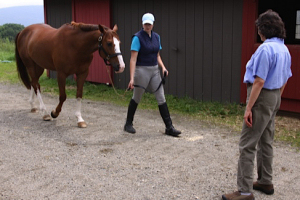 When
I watched the horse walk back and forth in a direct line from me, I
could see the horse was more labored in bringing the right shoulder
forward, was drifting to the left with his body, and was delayed in
bringing his left hind forward. I asked the rider if he felt the
horse needed more of the rider’s left leg to keep the horse
straight. I also asked if the horse was harder going to the right,
did the horse drift left over the jump and possibly knock a rail
with the left hind? The rider exclaimed: “How did you know? That is
exactly what he has been doing”. I don’t let the rider’s
astonishment go to my head, because it is simply understanding
muscular kinetics or a simple gait analysis at the walk. When
I watched the horse walk back and forth in a direct line from me, I
could see the horse was more labored in bringing the right shoulder
forward, was drifting to the left with his body, and was delayed in
bringing his left hind forward. I asked the rider if he felt the
horse needed more of the rider’s left leg to keep the horse
straight. I also asked if the horse was harder going to the right,
did the horse drift left over the jump and possibly knock a rail
with the left hind? The rider exclaimed: “How did you know? That is
exactly what he has been doing”. I don’t let the rider’s
astonishment go to my head, because it is simply understanding
muscular kinetics or a simple gait analysis at the walk.
Once you watch a horse move at the walk
several times, it will be easy to see as well. Let the movement come
to you. Don’t try to see it, just let it present itself to your eye.
The more you push at it in trying to see it, the less you will see.
(Just my own experience)
Again, you get the best view of muscle
function at the walk. The slower the horse moves, the more muscle he
has to use. If a horse is muscularly tight in any part of his body,
it will show up at the walk.
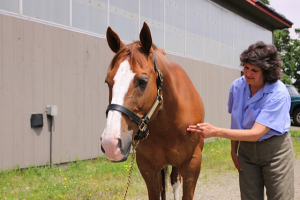 To
evaluate muscle tightness causing restrictions, one must watch the
horse walk as I described in the above paragraph. Secondly, look at
the trunk of the horse. Do not focus on the legs because the power
for the legs come from the shoulder and pelvic girdles which are
located on the trunk. So when evaluating the front end of the horse,
look at the points of the shoulders to see which shoulder moves
easily, without a delay or labored. Which shoulder is labored in
coming forward? Then, have the horse walk away from you and look at
the hind end. Focus on the big muscles, in the flank region which
are the gluteal muscles. Look at the hamstrings which are found in
the hind end as well. In combination, these muscles bring the hind
legs back and forth, as in behind the body and underneath the body. To
evaluate muscle tightness causing restrictions, one must watch the
horse walk as I described in the above paragraph. Secondly, look at
the trunk of the horse. Do not focus on the legs because the power
for the legs come from the shoulder and pelvic girdles which are
located on the trunk. So when evaluating the front end of the horse,
look at the points of the shoulders to see which shoulder moves
easily, without a delay or labored. Which shoulder is labored in
coming forward? Then, have the horse walk away from you and look at
the hind end. Focus on the big muscles, in the flank region which
are the gluteal muscles. Look at the hamstrings which are found in
the hind end as well. In combination, these muscles bring the hind
legs back and forth, as in behind the body and underneath the body.
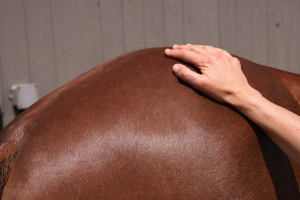
Look primarily at the large gluteal muscles
and compare the left to the right gluteal. Is one gluteal or large
muscle moving up and down down as the horse walks and is the other
staying higher up in the air and not dropping down? Is one leg
slower or delayed in coming forward underneath the body? Also look
at straightness. Is the horse walking straight or is he crooked,
drifting to one direction or another. These are some of the simple
ways to look at a horse to determine muscle restrictions. Good
motion and good performance demands mechanical efficiency with an
ease of motion. Once the ease of motion is interrupted, the good
motion is interrupted. Move Better, Perform Better, Last Longer!!!!
|
|
|
|
|
|


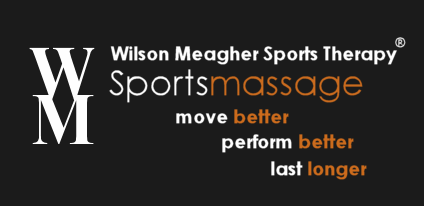
 I
get the best view of muscle function at the walk. The slower one
moves, the more muscle one uses. Before I work on a horse, I often
ask to see the horse walk in a straight line away from me and then
back toward me. I can see fairly well any restriction that may be
caused by simple muscle tightness. I can relate what I see to the
way a horse performs. For instance, if a horse is delayed in
bringing his right shoulder forward, then he may be harder in
extending the shoulder in such moves as picking up the right lead
canter, or in lengthening’s. I was recently called to a barn to use
sportsmassage on a show jumper competition horse.
I
get the best view of muscle function at the walk. The slower one
moves, the more muscle one uses. Before I work on a horse, I often
ask to see the horse walk in a straight line away from me and then
back toward me. I can see fairly well any restriction that may be
caused by simple muscle tightness. I can relate what I see to the
way a horse performs. For instance, if a horse is delayed in
bringing his right shoulder forward, then he may be harder in
extending the shoulder in such moves as picking up the right lead
canter, or in lengthening’s. I was recently called to a barn to use
sportsmassage on a show jumper competition horse. When
I watched the horse walk back and forth in a direct line from me, I
could see the horse was more labored in bringing the right shoulder
forward, was drifting to the left with his body, and was delayed in
bringing his left hind forward. I asked the rider if he felt the
horse needed more of the rider’s left leg to keep the horse
straight. I also asked if the horse was harder going to the right,
did the horse drift left over the jump and possibly knock a rail
with the left hind? The rider exclaimed: “How did you know? That is
exactly what he has been doing”. I don’t let the rider’s
astonishment go to my head, because it is simply understanding
muscular kinetics or a simple gait analysis at the walk.
When
I watched the horse walk back and forth in a direct line from me, I
could see the horse was more labored in bringing the right shoulder
forward, was drifting to the left with his body, and was delayed in
bringing his left hind forward. I asked the rider if he felt the
horse needed more of the rider’s left leg to keep the horse
straight. I also asked if the horse was harder going to the right,
did the horse drift left over the jump and possibly knock a rail
with the left hind? The rider exclaimed: “How did you know? That is
exactly what he has been doing”. I don’t let the rider’s
astonishment go to my head, because it is simply understanding
muscular kinetics or a simple gait analysis at the walk.  To
evaluate muscle tightness causing restrictions, one must watch the
horse walk as I described in the above paragraph. Secondly, look at
the trunk of the horse. Do not focus on the legs because the power
for the legs come from the shoulder and pelvic girdles which are
located on the trunk. So when evaluating the front end of the horse,
look at the points of the shoulders to see which shoulder moves
easily, without a delay or labored. Which shoulder is labored in
coming forward? Then, have the horse walk away from you and look at
the hind end. Focus on the big muscles, in the flank region which
are the gluteal muscles. Look at the hamstrings which are found in
the hind end as well. In combination, these muscles bring the hind
legs back and forth, as in behind the body and underneath the body.
To
evaluate muscle tightness causing restrictions, one must watch the
horse walk as I described in the above paragraph. Secondly, look at
the trunk of the horse. Do not focus on the legs because the power
for the legs come from the shoulder and pelvic girdles which are
located on the trunk. So when evaluating the front end of the horse,
look at the points of the shoulders to see which shoulder moves
easily, without a delay or labored. Which shoulder is labored in
coming forward? Then, have the horse walk away from you and look at
the hind end. Focus on the big muscles, in the flank region which
are the gluteal muscles. Look at the hamstrings which are found in
the hind end as well. In combination, these muscles bring the hind
legs back and forth, as in behind the body and underneath the body.

